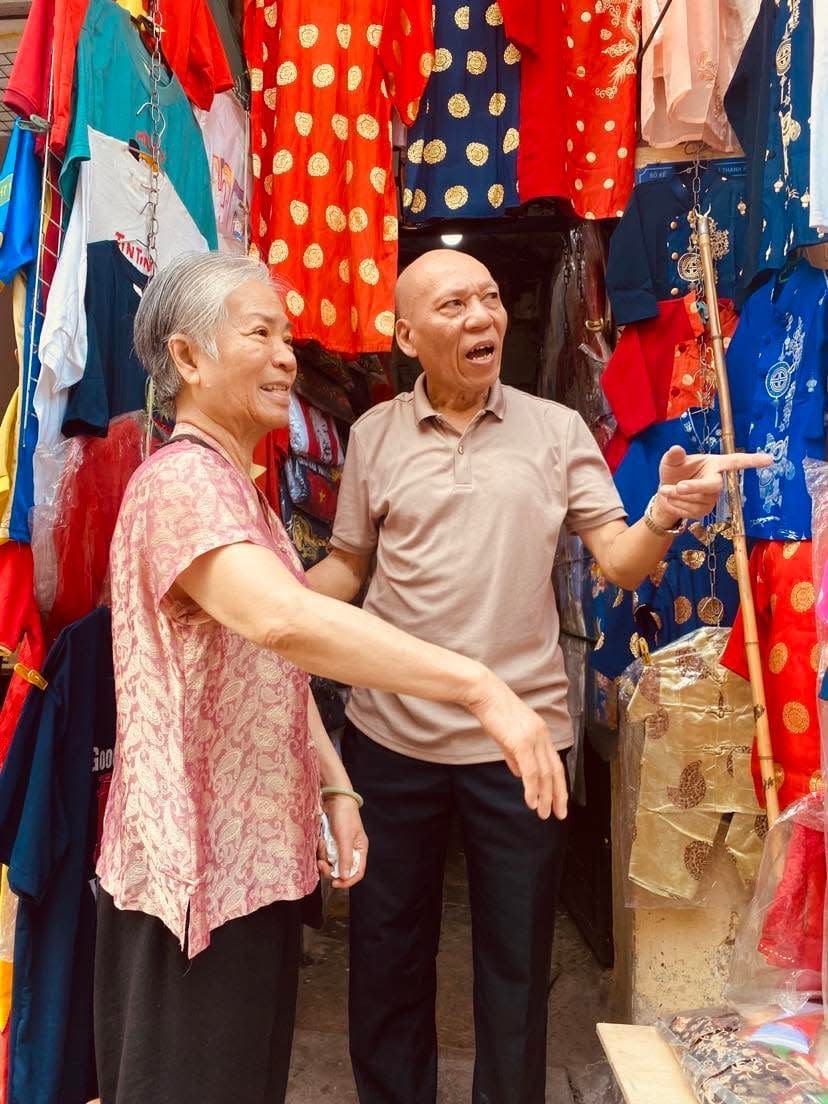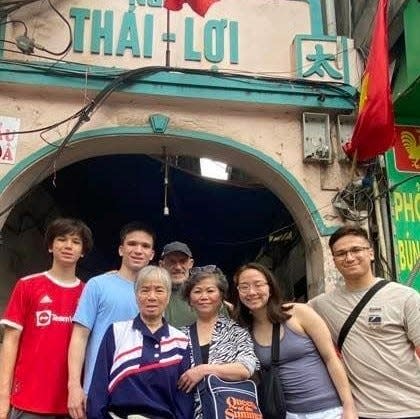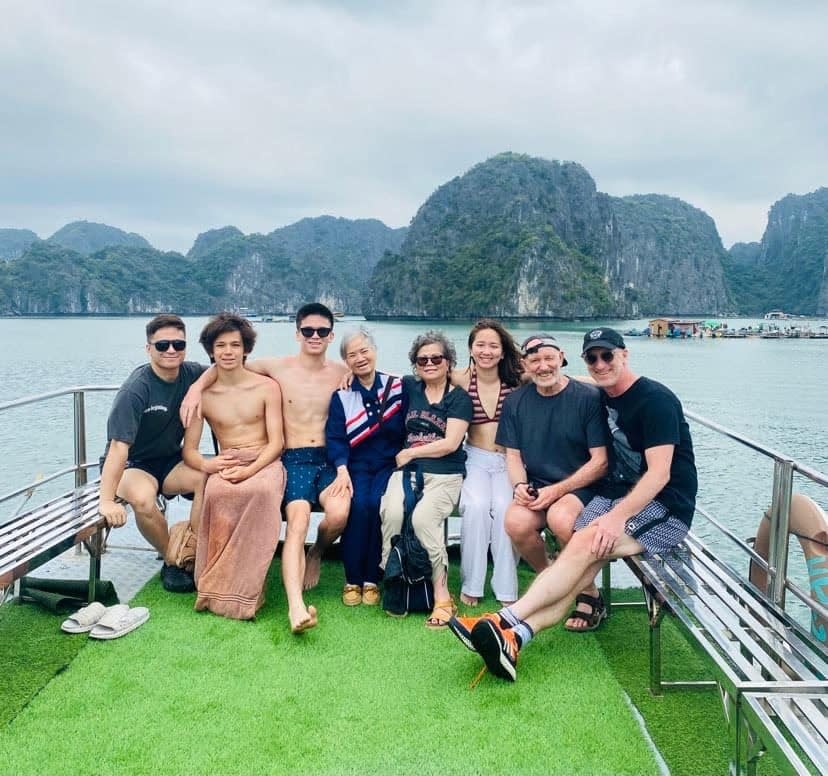Finding home in Hanoi: Learning about our past in Vietnam helps my kids see beyond legacy of war
"Once upon a time, I used to visit my grandmother there."
We're in northern Vietnam and my mom, Duc Le, is pointing across the street to a narrow, four-story building. It's a sweltering day in the capital city of Hanoi, where she was born in 1940. Now, she's revisiting the building with her own grandchildren, my four kids ages 16 to 25, all born in the Washington, D.C., area.
Mom's talking a mile a minute in Vietnamese and I'm racing to translate: How the ground floor used to be the family bookstore and her own mother had grown up in the living quarters above. How after the Geneva accords split the nation in 1954 and Mom's family fled south, the northern communist regime allowed her grandmother to keep a part of this Hanoi home and divided the rest among strangers.
Then Mom asked one of my sons to take her across the street. She later explained that she had a feeling: "I just wanted to ask the neighboring store owners whether they remembered my grandmother and our bookstore. You never know."
Next thing I knew, Mom's talking animatedly to an older man who runs a tourist shop next door. Turns out, he's one of Mom's cousins! Vu Quy's father was one of her mother's brothers. And my mom's first cousin still lives with his wife on the second floor. Mom hadn't seen him since she was 14, when her family flew south to Saigon.

Of all the things I expected from this trip with my mother, my husband, our children and my father-in-law back to northern Vietnam, reuniting Mom with such a close relative was not one of them. And the surprise came on only our second day of this journey. The trip, planned for 2020 but delayed by COVID-19 until last month, would surpass our dreams – not only of revisiting my mother's birthplace and places where my kids are named after, but also of introducing them to unforgettable adventures.
Five decades since the fall of Saigon
This is not our first visit back to Vietnam. Since 1975, when Saigon fell to the Hanoi regime and my parents took us five children to America, we've returned several times. But for my kids, the first and last time we took them to their motherland was in the early 2000s, when they were too little to understand the importance of our return.
In early May, as soon as we landed, the 45-minute ride from the airport into Hanoi triggered so many memories for my mom, she chattered excitedly nonstop. Because we couldn't check into our Airbnb until after lunch, we asked the driver to take us straight to a couple of addresses where she had grown up. One was a soap factory my grandparents had owned that included a villa where my mother had lived the first five years of her life.

I wrote about this Savonta factory in 1994 when the Los Angeles Times sent me to report on the United States normalizing relations with Vietnam. Saigon, where I was born, felt real on my return as an adult. But I had never been to Hanoi, which seemed more like a myth repeated by my elders who hadn't been back since 1954. However, they still remembered the family addresses. For the soap factory, they said, look for an entrance bearing your uncles' names, Thai and Loi. They added that graceful trees used to line the walk leading from the gate to the one-story villa and a pond, but they were resigned to knowing what war could erase.
Well, on my first trip to Hanoi, gone were the trees and the pond, but I found the entrance and the villa, both deteriorating and surrounded by wall-to-wall homes. Still standing, however. Three decades later, I'm excited to show the war-torn villa to my kids.
Well, all that's left is the entrance bearing my uncles' names, "Thai-Loi." It has been repainted and has earned its own official street sign, but I still felt deflated. Mom led us down the alley into a warren of small dwellings – walking like a little girl lost in a foreign place that no longer resembles her memories.
On the other hand, my kids marveled at the still standing entrance and the street sign into the alley. And just like that, with a new family photo, we made a new family memory.
The Vietnamese origins of my American children's names
Two more mythical places I often heard about as a child were Hanh-Thien village, where my maternal grandfather was born, and Thai-Binh province, the birthplace of my paternal grandfather. I wanted my kids to carry on those names, and I'm forever grateful that my husband, Bob, agreed to name our oldest son Hanh-Thien, now 25, and our daughter Thai-Binh, now 24.
This July 4, I pledge allegiance: It took two wars to make me an American
We first brought them to meet their namesakes two decades ago. Then, it took five hours of driving from Hanoi over roads full of potholes. This time, the drive on highways and freeways was just a couple of hours from the capital.
As I wrote about my maternal Hanh-Thien village for the L.A. Times when I was still in my 20s: "All these years I had thought (our) family was honored in this village by a simple altar in a corner of a Buddhist pagoda. But my ancestors are memorialized with an entire shrine built in 1929, complete with a red altar 12 feet high and a framed family tree. ... On a framed list naming descendants from overseas who had sent money to help with the shrine’s upkeep, there were the names of my grandmother, parents and relatives."
Last month in my paternal Thai-Binh province, we also found a family tree in a shrine, just a few doors down from where my dad used to visit his grandfather. When I found my name and those of my siblings on the family tree below our parents, grandparents and great-grandparents, I couldn't help it – I squealed.
I know that for my kids, growing up in Northern Virginia with Vietnamese first names wasn't easy. In school and on sports teams, Hanh-Thien switched to HT, and Thai-Binh has found it simpler just to go by Thai. But it still means so much to my mother and me that they now are old enough to decide for themselves to revisit their roots, not just being taken there as when they were 5 and 4.
In Thai-Binh province, distant cousins living near the family shrine welcomed us with a five-course lunch from the chickens they raised and the vegetables they grew. Despite sweating in the record heat wave and humidity in the open-air home with no air conditioning, my four kids chowed down the food and chugged beers with store-bought ice as they and these relatives they just met laughed in their mutual effort to communicate across the language barrier. They made me so proud.
A song sums up Vietnamese history until 1975: A thousand years enslaved by the Chinese enemy; a hundred years dominated by the French; 20 years of daily civil war – a mother's legacy I leave to you.
But in 2023, the Vietnamese people my family met on this trip – relatives, entrepreneurs, hotel staff, students practicing their English as bartenders, rental car drivers, tourist boat operators – know their heritage but are too busy working on leaving their own legacy beyond what they call the American War.

Whose war was it?
Whether you call it the Vietnam War or the American War, the Le-Elston family – like millions of other families – wasn't spared by history. In both North and South Vietnam, 4 million soldiers and civilians were killed or wounded. Of the 3 million U.S. troops sent to Vietnam, 60,000 died and 150,000 were wounded (including my future father-in-law).
My dad, Nghia Le, a former South Vietnamese lieutenant who before 1954 believed the Viet Minh were boy scouts fighting against French colonialism until the boy scouts turned communists, died as a U.S. citizen in Phoenix in 1991.
My father-in-law, Bob Elston Sr., a U.S. Army first lieutenant posted in South Vietnam in 1968 when he learned my future husband was born in New Jersey, was determined to accompany us on this journey: "I knew what an important trip this would be for the kids."
Learning Vietnamese history: How I landed a Hollywood movie and gained a 'Heaven and Earth' family
One night on the trip when Hanh-Thien, our 25-year-old, and Kien-Tam, 21, took their youngest sibling, Thai-Son, 16, on a boys' night out, I couldn't help but think of my father and father-in-law as young men on the front lines.
But watching my mother and my children revisit her birthplace and rediscovering Vietnam together, I saw my past and my future on one page – a page in a new chapter not inked by legacy of war but filled with laughter and adventure in peace, whether cruising on a boat pass a floating fishing village amid limestone giants or riding motorbikes among lush mountains and rice fields.
Opinion alerts: Get columns from your favorite columnists + expert analysis on top issues, delivered straight to your device through the USA TODAY app. Don't have the app? Download it for free from your app store.
This trip almost didn't happen, again. Once COVID-19 vaccinations reopened the world, we just found it difficult to justify the costs and to juggle all our work/school schedules. It seemed out of reach. But daughter Thai-Binh persisted. Last Christmas morning, the 24-year-old gave me the "Lonely Planet" travel book for Vietnam and pleaded with my mother that a trip back to family roots wouldn't be the same without her. My mom melted and agreed to put up with the long flights and the heat of the tropics. And with her will, we all found a way.
Mom's turning 83 this year, a survivor of twice escaping war and two cancer surgeries. This was likely her last visit to her birthplace. My mother's once upon a time is no longer a myth to my children. Whatever changes and challenges lie ahead, may this historic Vietnamese trip help them face their American future.
Thuan Le Elston, a member of USA TODAY's Editorial Board, is the author of "Rendezvous at the Altar: From Vietnam to Virginia." Follow her on Twitter: @thuanelston
You can read diverse opinions from our Board of Contributors and other writers on the Opinion front page, on Twitter @usatodayopinion and in our daily Opinion newsletter. To respond to a column, submit a comment to letters@usatoday.com.
This article originally appeared on USA TODAY: Vietnam revisited: What I learned taking my mom back to her birthplace

